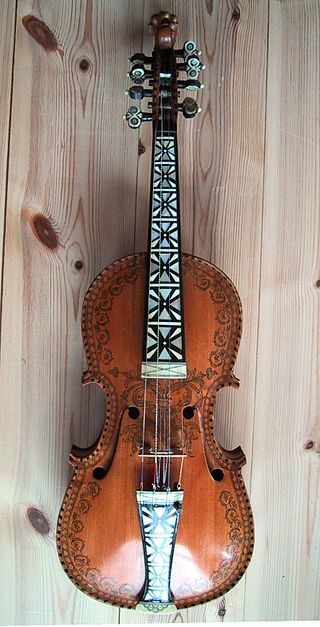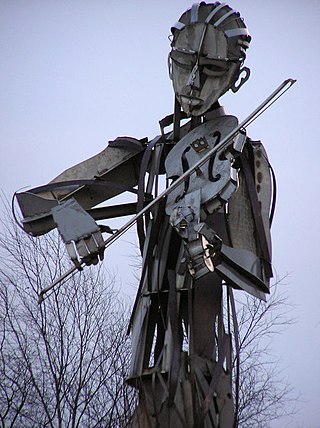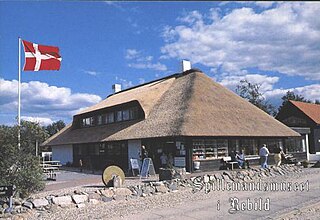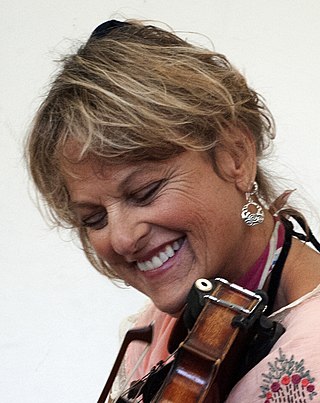
A fiddle is a bowed string musical instrument, most often a violin. It is a colloquial term for the violin, used by players in all genres, including classical music. Although in many cases violins and fiddles are essentially synonymous, the style of the music played may determine specific construction differences between fiddles and classical violins. For example, fiddles may optionally be set up with a bridge with a flatter arch to reduce the range of bow-arm motion needed for techniques such as the double shuffle, a form of bariolage involving rapid alternation between pairs of adjacent strings. To produce a "brighter" tone than the deep tones of gut or synthetic core strings, fiddlers often use steel strings. The fiddle is part of many traditional (folk) styles, which are typically aural traditions—taught "by ear" rather than via written music.

Bluegrass music is a genre of American roots music that developed in the 1940s in the Appalachian region of the United States. The genre derives its name from the band Bill Monroe and the Blue Grass Boys. Like mainstream country music, it largely developed out of old-time string music, though in contrast, it is traditionally played exclusively on acoustic instruments and also has roots in traditional English, Scottish and Irish ballads and dance tunes, as well as in blues and jazz. It was further developed by musicians who played with Monroe, including 5-string banjo player Earl Scruggs and guitarist Lester Flatt. Monroe characterized the genre as "Scottish bagpipes and ole-time fiddlin'. It's a part of Methodist, Holiness and Baptist traditions. It's blues and jazz, and it has a high lonesome sound."

Cajun music, an emblematic music of Louisiana played by the Cajuns, is rooted in the ballads of the French-speaking Acadians of Canada. Although they are two separate genres, Cajun music is often mentioned in tandem with the Creole-based zydeco music. Both are from southwest Louisiana and share French and African origins. These French Louisiana sounds have influenced American popular music for many decades, especially country music, and have influenced pop culture through mass media, such as television commercials.

A Hardanger fiddle is a traditional stringed instrument considered to be the national instrument of Norway. In modern designs, this type of fiddle is very similar to the violin, though with eight or nine strings and thinner wood. The earliest known example of the hardingfele is from 1651, made by Ole Jonsen Jaastad in Hardanger, Norway. Originally, the instrument had a rounder, narrower body. Around the year 1850, the modern layout with a body much like the violin became the norm.

Peter Knight is an English folk musician, a former member of British folk rock group Steeleye Span. Born in London, Knight learnt to play the violin and mandolin as a child before going to the Royal Academy of Music from 1960 to 1964. The recordings of the Irish fiddler Michael Coleman inspired him to take part in Irish pub sessions. He teamed up with guitarist and singer Bob Johnson until 1970 when he joined Steeleye Span. The parting was short-lived, as Johnson himself also joined Steeleye Span in 1972. Since 2016, he has performed as a duo with Bellowhead founder and melodeon player, John Spiers.

J.P.P. is a group of Finnish folk musicians from Kaustinen. The group still uses the Kaustinen traditional settings with fiddles, harmonium and double bass, although their arrangements are more advanced than those of earlier generations of traditional musicians in the area. The group's repertoire consists of traditional tunes, as well as newly-composed music in old-style dance rhythms -- polskas, waltzes, schottisches, etc. -- as well as some Finnish-style tangos, and some jazz and bluegrass influences too.
Melvin Wine was an American Appalachian fiddler from the state of West Virginia. He was a lifelong resident of Copen, in Braxton County, West Virginia.

The fiddle is one of the most important instruments in the traditional repertoire of Irish traditional music. The fiddle itself is identical to the violin, however it is played differently in widely varying regional styles. In the era of sound recording some regional styles have been transmitted more widely while others have become more uncommon.

The Art of Virtue is the second CD by Nashville, Tennessee-based singer/songwriter Adrienne Young and her band, Little Sadie.
Colyn C. Fischer is an American violinist that has played the violin since the age of three and has been Scottish fiddling since the age of five. As a teenager, he studied with a number of the great fiddlers of Scotland, such as Ian Powrie and Alasdair Hardy, and of the United States, including John Turner and Bonnie Rideout. He holds a Bachelor of Music Performance in Violin from Wheaton College, Illinois, and has recorded with various ensembles in genres including jazz, classical, rock and Scottish.

The Huon Valley, or simply the Huon, is a valley and geographic area located in southern Tasmania, Australia. The largest town is Huonville, with other smaller towns spread across the area. It includes Australia's most southern permanent settlement at Southport. The Huon Valley Council area had a population of 15,140 in 2011. Famed for its apple growing, the Valley was first settled by British colonists in the 1820s; prior to settlement the Huon Valley area was inhabited by the Mouheneenner, Nuenonne, Mellukerdee and Lyluequonny people.

Walker's Run is an acoustic bluegrass band based out of Lexington, Virginia who also play New Grass and Jazz music.

Old timefiddle is the style of American fiddling found in old-time music. Old time fiddle tunes are derived from European folk dance forms such as the jig, reel, breakdown, schottische, waltz, two-step, and polka. When the fiddle is accompanied by banjo, guitar, mandolin, or other string instruments, the configuration is called a string band. The types of tunes found in old-time fiddling are called "fiddle tunes", even when played by instruments other than a fiddle.
"Blues fiddle" is a generic term for bowed, stringed instruments played on the arm or shoulder that are used to play blues music. Since no blues artists played violas, the term is synonymous with violin, and blues players referred to their instruments as "fiddle" and "violin".

Canadian fiddle is the aggregate body of tunes, styles and musicians engaging the traditional folk music of Canada on the fiddle. It is an integral extension of the Anglo-Celtic and Québécois French folk music tradition but has distinct features found only in the Western hemisphere.

Evald Thomsen (1913–1993) was a Danish fiddler and collector and promoter of Danish traditional music. Born in Siem by Skørping in Northern Jutland, Thomsen was taught fiddle from age 7, and played to local dances already as a young boy. He began to collect tunes and instruments. He founded the Rebild Fiddlers, and the Rebild museum of Traditional music. In 1931 he moved to Funen where his wife was from, and he stayed there to 1942 when he went back home to Himmerland.
Kamerunga is an Australian folk band from Cairns, Queensland, consisting of six members. The band's music derives from traditional Celtic-influenced Australian folk music, which it mixes with elements of rock, reggae, jazz and blues. It plays classic Australian folk songs using these elements to produce eclectic and unusual versions of recognisable tunes. Instruments used in Kamerunga's music include guitar, drums, mandolin, fiddle, saxophone, keyboards and violin.
Torleiv Bolstad was a Norwegian musician and Hardanger fiddle player. He won the Norwegian Landskappleiken four times, in 1947, 1957, 1970 and 1971.

Sue Draheim was an American fiddler, boasting a more than forty year musical career in the US and the UK. Growing up in North Oakland, Draheim began her first private violin lessons at age eleven, having started public school violin instruction at age eight while attending North Oakland's Peralta Elementary School. She also attended Claremont Jr. High, and graduated from Oakland Technical High School in 1967.
Vivian Williams was an American fiddler, composer, recording artist, and writer. She won national fiddling titles, including the National Oldtime Fiddlers Contest, and in 2013 she was inducted into the North American Old Time Fiddlers Hall of Fame.













